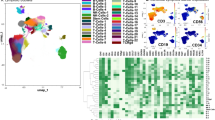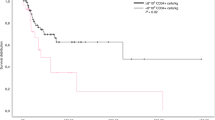Abstract
We analyzed the relationship between the reinfusion of large or very large amounts of peripheral blood progenitor cells (PBPC) and hematologic toxicity in twenty-one advanced breast cancer patients subjected to a myeloablative dose of melphalan at the end of a high-dose sequential chemotherapy (HDSC) program. We also evaluated the influence of the white blood cell (WBC) count to predict an optimal PBPC harvest after high-dose chemotherapy and growth factor priming. Twenty-one patients with high-risk or metastatic breast cancer sequentially received: high-dose cyclophosphamide (HD-Cy) and G-CSF followed by PBPC harvest, HD-methotrexate plus vincristine, HD-doxorubicin, cisplatin and finally HD-melphalan 200 mg/m2 (HD-L-PAM) followed by PBPC reinfusion. No growth factor was administered after HD-L-PAM. CD34+ cytofluorimetric analysis, WBC count and clonogenic assays were employed to monitor circulating cells and to analyze the PBPC harvest. Correlation between different PBPC doses and hematologic toxicity as well as leukocyte and platelet recovery time was attempted. Patients received a median number of 16 (4–25.1) × 106/kg CD34+ cells, 81.3 (30.8–228) × 104/kg CFU-GM and 4.2 (1.3–7.3) × 108/kg nucleated cells (NC) after HD-L-PAM. The number of days with fewer than 1 × 109/l leukocytes and 20 × 109/l platelets were 6 (range 4–9) and 0 (range 0–3), respectively. The CD34+ cell dose significantly correlated with both platelet count nadir (r = 0.73) and time to 50 × 109/l platelets (r = 0.7), but did not correlate with time to reach more than 1 × 109/l WBC count (r = 0.2). In particular, we found that in 12 patients given very large amounts of CD34+ cells, ranging between 15.8 and 25.1 × 106/kg (V-LA-CD34+), the platelet nadir count never fell below 20 × 109/l and platelet transfusions were not required. Conversely, nine patients who received only large amounts of CD34+ cells, ranging between 4 and 12 × 106/kg (LA-CD34+), experienced a platelet nadir lower than 20 × 109/l and required 2 days (range 1–4) to achieve independence from platelet transfusions (P = 0.001 and P = 0.0005). The requirement for packed red blood cells (RBC) was 1.5 vs 3 units in the V-LA-CD34+ and LA-CD34+ groups respectively (P = 0.063). The analysis of 44 PBPC collections demonstrated that 29 aphereses performed with a WBC count <20 × 109/l yielded a mean of 312 ± 43 × 106 CD34+ cells and 1831 ± 201 × 104 CFU-GM, whereas 15 collections performed with WBC count >20 × 109/l yielded 553 ± 64 × 106 CD34+ cells and 3190 ± 432 × 104 CFU-GM (P = 0.004). In conclusion, our data suggests that V-LA-CD34+ eliminates severe thrombocytopenia and platelet transfusion requirements in breast cancer patients subjected to HD-L-PAM, and higher PBPC collections seems to coincide with WBC count higher than 20 × 109/l after HD-Cy and G-CSF mobilization. These results justify a prospective study to establish whether large doses of CD34+ cells result in significant clinical benefits.
This is a preview of subscription content, access via your institution
Access options
Subscribe to this journal
Receive 12 print issues and online access
$259.00 per year
only $21.58 per issue
Buy this article
- Purchase on Springer Link
- Instant access to full article PDF
Prices may be subject to local taxes which are calculated during checkout
Similar content being viewed by others
Author information
Authors and Affiliations
Rights and permissions
About this article
Cite this article
Benedetti, G., Patoia, L., Giglietti, A. et al. Very large amounts of peripheral blood progenitor cells eliminate severe thrombocytopenia after high-dose melphalan in advanced breast cancer patients. Bone Marrow Transplant 24, 971–979 (1999). https://doi.org/10.1038/sj.bmt.1702008
Received:
Accepted:
Published:
Issue Date:
DOI: https://doi.org/10.1038/sj.bmt.1702008
Keywords
This article is cited by
-
Autologous hematopoietic stem cell transplantation in multiple myeloma and lymphoma: an analysis of factors influencing stem cell collection and hematological recovery
Medical Oncology (2012)
-
International myeloma working group (IMWG) consensus statement and guidelines regarding the current status of stem cell collection and high-dose therapy for multiple myeloma and the role of plerixafor (AMD 3100)
Leukemia (2009)



